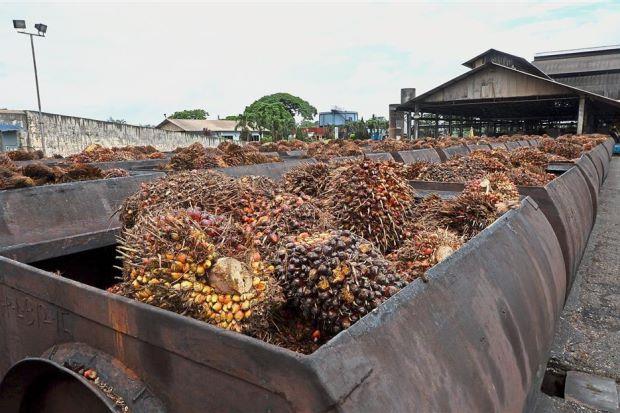
Forex stability: The plantations giant says it does not expect to book a huge forex translation loss again for the third quarter ending March 31.
THE foreign exchange (forex) woes faced by IOI Corp Bhd, whose underlying business improvement has been overshadowed by the impact of the weakening ringgit in the three months to December 2016, are expected to ease in the months ahead.
This comes as the Malaysian currency has become relatively more stable, thanks to Bank Negara’s newly implemented forex market stabilisation programme, while IOI itself has internally implemented a forex-risk diversification exercise involving its US dollar-denominated loans.
On that basis, the plantations giant says it does not expect to book a huge forex translation loss again for the third quarter ending March 31, 2017.
IOI had recorded an unrealised forex translation loss of RM330mil on its US dollar borrowings in the second quarter ended Dec 31, 2016.
On top of that, it had also incurred RM23.4mil in fair value loss on derivative instruments, which are primarily trade-related forex forward contracts, after the ringgit depreciated below the exchange rate that IOI had locked in, during the period.
That was the quarter that saw the ringgit, along with many emerging market currencies, fall sharply against the US dollar amid a global bond market rout and rallying US equity market after Donald Trump won the
US presidential election in early November. The ringgit’s value vis-a-vis the greenback then was further impacted by speculative activities in the offshore ringgit NDF, non-deliverable forward, market.
According to IOI, the group’s unrealised forex translation loss during the quarter in review was based on the end-December 2016 exchange rate of US$1 to RM4.48.
However, the company reckons that there is now less volatility in the ringgit’s exchange rate after the central bank stepped in to curb speculative offshore trading the in Malaysian currency.
“Since Bank Negara took the forex market stabilisation measures in December 2016, the volatility of ringgit against the US dollar has reduced substantially... with the reduced volatility and current US dollar exchange rate, we do not foresee substantial translation loss in our third-quarter result,” an IOI spokesperson says in an email to StarBizWeek.
High US dollar exposure
IOI has significant exposure to US dollar as the bulk of its debts are denominated in the greenback.
For instance, its filings show that almost 80% of the group’s total borrowings of RM7.49bil at Dec 31, 2016, were denominated in US dollar and 8% in euro. In absolute terms, its total US dollar-denominated debt stood at US$1.33bil (RM5.91bil), while total euro-denominated borrowings were 129.8 million euros (RM610.61mil) then.
Such debt composition makes the group’s financial position vulnerable to fluctuations in US dollar.
To put that into perspective, a sensitivity analysis by CIMB Research indicates that every 10 sen change in the ringgit-to-US dollar exchange rate could lead to a forex translation loss/gain of RM148mil for IOI.
Nevertheless, IOI recently revealed that it has started paring down its US dollar debt by refinancing and swapping some of them into euro-denominated loan as part of a risk-management strategy and to reduce borrowing costs.
“We have in total swapped US$200mil loan into euro-denominated loan. In addition, we have taken new euro loan of 95 million for our acquisition of Germany oleochemical business,” IOI says.
In the interim, however, the group reckons that the volatility of ringgit-to-US dollar exchange rate will continue to affect the non-cash flow forex translation gain/loss arising mainly from its medium to long dated US dollar-denominated borrowings, as well as the fair value gain/loss on derivative financial instruments.
Back on track
Because of the substantial forex translation loss on its US dollar borrowings and fair value loss on derivative instruments, IOI saw its net profit decline 98% to RM15.6mil, or 0.25 per share, for the second quarter of its financial year (FY) ending June 30, 2017. This compares with a net profit of RM703.7mil, or 11.17 sen per share, in the previous corresponding quarter.
Excluding the forex translation and fair value on derivative losses, however, IOI’s core net profit stood at RM381mil, which represented an increase of 53.5% year-on-year (y-o-y), thanks to higher crude palm oil (CPO) and palm kernel average selling prices as well as improvement in downstream margins amid a tight supply in the industry.
During the quarter in review, IOI saw a revenue growth of 23.5% y-o-y to RM3.67bil, driven by higher selling prices.
The average CPO price realised for second quarter of FY17 stood at RM2,768 per metric tonne, compared with RM2,144 per metric tonne in the previous corresponding period, while the average palm kernel price realised was RM2,882 per metric tonne, compared with RM1,631 per metric tonne previously.
Analysts note the growth of IOI’s core earnings is an underlying improvement in its business operations, with the firm prices of CPO and palm kernel driving its plantation segment, and the reinstatement of its Roundtable on Sustainable Palm Oil (RSPO) certification since August last year enabling the company to regain its premium pricing for downstream products to boost its manufacturing segment.
“Growth in the company’s core net profit is reflective of its improving operations. The company is doing pretty well actually,” JF Apex Securities analyst Low Zy Jing says.
“Aside from firm CPO and palm kernel prices, which will help bolster its plantations segment, the reinstatement of its RSPO certification has helped the company regain some of the customers it lost when the certification on its entire oil palm production was suspended in April 2016, as well as to regain premium pricing for its downstream products.
“So, we expect IOI’s prospects going forward to improve,” he explains.
In its results announcement, IOI has said that it is now actively engaging with its stakeholders to rebuild its sustainability credentials, which will benefit its downstream manufacturing business, particularly the specialty oils and fats sub-segment.
“Any effort to improve our sustainability practices and credentials will have an immediate impact on our business. More importantly, we hope to see these efforts giving sustainable medium and long term benefits to our business,” IOI explains.
The group points out that it currently has unutilised capacities in several existing plants for increased production in its specialty fats business. In addition, its new plant Xiamen, China, is scheduled to be completed in the middle of this year.
This, it says, will help the group expand its specialty fats business.
Meanwhile, IOI expects CPO and palm kernel prices to remain firm in the current quarter due to low stocks, and this will help drive growth in its upstream plantation business for the third quarter of FY17.
But the firm prices of CPO and palm kernel, however, will mean higher raw material costs for the group’s resource-based manufacturing segment, and this could affect the performance of the downstream division in the third quarter of FY17.
According to UOBKayHian Research, IOI’s resource-based manufacturing segment will take time to recover.
“The improvement (of the division’s performance since the second quarter) is likely to continue into the second half of FY17, but the concern is the higher raw material prices and lower volume in the third quarter of FY17 could drag down its performance for that quarter,” UOBKayHian Research said in its recent report.
The brokerage, however, notes more than half of IOI’s earnings come from sales of CPO and palm kernel, while a third comes from its downstream products.
Hence, movements in CPO prices will affect the group’s plantation segment profits more so than its manufacturing segment.
“With rising contribution from its 31% Indonesian associate Bumitama Agri, IOI’s earnings are therefore increasingly influenced by CPO price movements,” UOBKayHian says.
The brokerage says the expected weaker performance of IOI in the second half of FY17 on the back of lower production to be mitigated by higher selling prices.
For the first half of FY17, IOI reported a net profit of RM120.4mil, compared with a net loss of RM40.7mil in the previous corresponding period.
The turnaround was mainly attributable to higher contribution from its plantation segment and lower net foreign currency translation loss on US dollar borrowings.
In general, IOI is expected to see earnings recovery in FY17 from FY16.
But analysts reckon this has already been priced in by the market, hence the counter is trading at relatively expensive valuations now.
IOI’s shares gained 9 sen to close at RM4.69 yesterday, valuing the company at around 26-27 times estimated FY17 earnings, compared with its five-year historical average of around 20 times.
A Bloomberg poll shows there are only four “buy” calls on IOI, against 12 “hold” and 10 “sell” calls on the counter, with the 12-month average target price pegged at RM4.40.
